(September 2, 1840 – July 3, 1887)
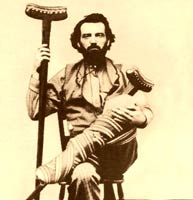 It was December 21, 1876 and a group of merry makers gathered in the dance hall of Las Animas, Colorado. It was a good time turned ugly when gunfighter Clay Allison turned on, shot and killed Deputy Sheriff Charles Faber.
It was December 21, 1876 and a group of merry makers gathered in the dance hall of Las Animas, Colorado. It was a good time turned ugly when gunfighter Clay Allison turned on, shot and killed Deputy Sheriff Charles Faber.
Faber was called to the hall to approach Allison about the fact he was walking around stomping on the feet of the dancers. Allison was earlier described in a physician’s report discharging him from the Confederate army as “partly maniacal.”
That’s just one colorful tale about Robert Clay Allison, the famed gunfighter, known as “Clay” who was born on September 2, 1840 near Waynesboro, Tennessee. The truth, however, was quite a bit different and a bit more grisly — read on.
His father was a Presbyterian minister who also worked in the cattle and sheep business and died when Clay was just five. Allison worked on the family farm until the age of 21.
When the American Civil War broke out, he joined the Confederate States Army on October 15, 1861, as a member of the Tennessee Light Artillery division. On January 15, 1862, he received a medical discharge, because of an old head injury that caused mood swings. But, on September 22, 1862, Allison reenlisted as a member of the 9th Tennessee Cavalry and he remained in that unit until the end of the war.
Upon returning home from the war, Allison became a member of the Ku Klux Klan and he was involved in several confrontations before leaving Tennessee for Texas with his family: brothers Monroe and John, sister Mary and her spouse Lewis Coleman.
But it was in New Mexico, that Allison, along with his brothers, developed his reputation as a dangerous man through carousing, hard drinking and shooting out lights with their handguns as they rode down the town’s main streets.
Starting around 1870-1873 around the Western Plains, Allison was involved in numerous altercations often with him using a knife during a fights. He reportedly believed himself to be fast with a gun but changed this attitude after being outdrawn in a friendly competition with a man named Mace Bowman. Bowman and Allison became friends, and Bowman is alleged to have worked with Allison to improve his “quick draw” skills.
January 7, 1874: Clay killed a gunman named Chunk Colbert, who picked up a fight with him after the two reportedly had dinner at Clifton House, an inn located in Colfax County, New Mexico. Colbert had allegedly already killed six men and had quarreled with Allison several years earlier.
Some reports allege that nine years earlier, Allison had killed Colbert’s uncle in a gunfight, but there’s no proof. What did happen here is that at some point during the dinner, Colbert attempted to raise his gun to shoot Allison, but the barrel bumped the table instead. Allison fired a round, hitting Colbert in the head, killing him. Asked later why Allison would accept a dinner invitation from a man who would likely try to kill him, Allison responded: “Because I didn’t want to send a man to hell on an empty stomach”. Over the next few years, Allison’s reputation as a gunman expanded significantly.
October 30, 1875: Allison is alleged to have led a mob to capture Cruz Vega, who was suspected of murdering a Methodist circuit rider. The mob hanged the man from a telegraph pole near Cimarron. On November 1, Vega’s family members, led by Vega’s uncle Francisco Griego, made threats around town about the lynching. They wandered into the Lambert Inn, came across Allison and accused him of involvement in the lynching. An argument ensued, and Griego pulled his gun. Allison responded in kind and shot Griego twice, killing him. On November 10, Allison was charged with murdering Griego, but the charges were later dropped as the shooting was ruled justifiable.
December 1876: Allison and his brother John stopped at a local saloon for drinks in Las Animas, Colorado. The local sheriff, Charles Faber of the Bent County Sheriff’s Department ordered the Allisons to relinquish their guns per a town ordinance making it illegal to possess guns inside town limits.
When the Allisons refused, Faber left, deputized two men, and returned to the saloon. Immediately upon re-enering, someone yelled “Look out!”, and the shooting started. It’s believed that the sheriff and his men fired the first shots. John Allison was shot three times. Clay Allison quickly fired four shots, killing Sheriff Faber. The deputized men fled, with Allison in pursuit, but they escaped. John survived and recovered and both Clay and John were later arrested for manslaughter but the charges were later dismissed. It was this gunfight more than any other that launched Clay Allison to legend as a gunfighter.
Allison, Dodge City & Wyatt Earp
March 1877: Clay Allison moved to Sedalia, Missouri then onward to Hays City, Kansas, where he established himself as a cattle broker. He soon arrived in Dodge City, Kansas, which was a bustling “cattle town” where laws were forcibly upheld. Dodge City’s deputy marshal was the famed lawman Wyatt Earp. Stories given by Earp’s biographer and by Earp himself, stated that Wyatt and friend Bat Masterson confronted Allison and his men in a saloon, and that Allison had backed down. Other reports say that a cattleman named Dick McNulty and Chalk Beeson, the owner of the Long Branch Saloon, intervened and convinced the cowboys to surrender their guns. Earp did not make this claim until after Allison’s death, much like Earp’s false claim that he arrested gunman Ben Thompson, also made after the latter’s death.
Charlie Siringo, who was a cowboy at the time but later became a prominent Pinkerton Detective, gave a written account of the incident, as he had witnessed it, also claiming it was actually McNulty and Beeson who ended the incident, and that Earp did not come into contact with Allison.
1880s & Death
From 1880 to 1883, Clay Allison ranched with his two brothers, John William and Jeremiah Monroe, in what was then Wheeler County, Texas, and present day Hemphill County, Texas. By 1883, he had sold his ranch and moved to Pope’s Wells, near the Pecos River crossing of the Texas-New Mexico line where he purchased another ranch. Clay and wife Dora had two daughters: Patti Dora Allison born August 9, 1885, in Colfax County and Clay Pearl Allison born February 10, 1888, seven months after her father’s death in Pecos, Texas.
July 3, 1887: Allison was hauling a load of supplies by wagon. The load shifted and a sack of grain fell off. When Allison tried to catch it, he fell from the wagon, and the wheel rolled over him. He broke his neck and died quickly. He was buried the next day at Pecos Cemetery in Pecos, Texas, and hundreds attended his funeral.
In a special ceremony held on August 28, 1975, t Clay Allison’s remains were re-interred at Pecos Park, just west of the Pecos Museum.
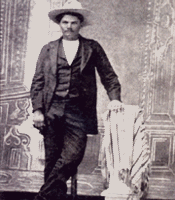






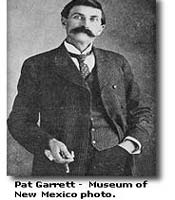
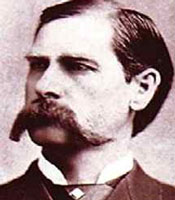
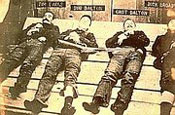
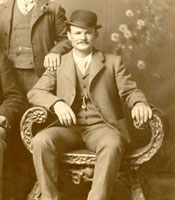
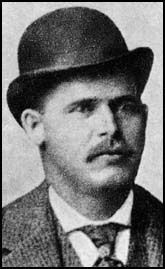 and other members of the camp who eventually formed ‘ The Wild Bunch” gang.Butch was sentenced to two years in the Wyoming State Prison in 1892 for cattle rustling. After his release, he went back to Brown’s Hole, collected some men and began a five year run of robbing banks and trains. They hid out in places like “Hole-in-the-Wall” and “Robber’s Roost”, deep canyons of northern Wyoming and southeastern Utah.
and other members of the camp who eventually formed ‘ The Wild Bunch” gang.Butch was sentenced to two years in the Wyoming State Prison in 1892 for cattle rustling. After his release, he went back to Brown’s Hole, collected some men and began a five year run of robbing banks and trains. They hid out in places like “Hole-in-the-Wall” and “Robber’s Roost”, deep canyons of northern Wyoming and southeastern Utah.
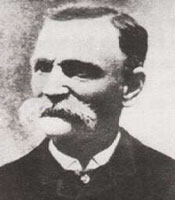 Master outlaw, Black Bart was born in 1829 . He was a California stagecoach robber whose real name was Charles E. Bolles, also known as Charles E. Boles, C.E. Bolton and Charles E. Bowles. Very little is known about him other than his thefts against Wells Fargo from 1875-1883.
Master outlaw, Black Bart was born in 1829 . He was a California stagecoach robber whose real name was Charles E. Bolles, also known as Charles E. Boles, C.E. Bolton and Charles E. Bowles. Very little is known about him other than his thefts against Wells Fargo from 1875-1883.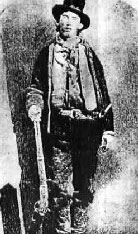 Billy the Kid was born Henry McCarty in 1859 in New York City. He moved west with his widowed mother, ending up in New Mexico in 1873. When his mother remarried, he took his stepfather’s name of Antrim, then later adopted the alias of William H. Bonney. He was usually known as just Billy the Kid.
Billy the Kid was born Henry McCarty in 1859 in New York City. He moved west with his widowed mother, ending up in New Mexico in 1873. When his mother remarried, he took his stepfather’s name of Antrim, then later adopted the alias of William H. Bonney. He was usually known as just Billy the Kid.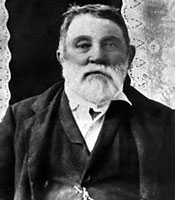 Judge Roy Bean, (a.k.a, The Hanging Judge”) who appointed himself “the law west of the Pecos River,” doled out some pretty weird and severe sentences from his combination barroom/courtroom.
Judge Roy Bean, (a.k.a, The Hanging Judge”) who appointed himself “the law west of the Pecos River,” doled out some pretty weird and severe sentences from his combination barroom/courtroom.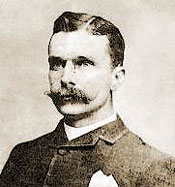
 It was December 21, 1876 and a group of merry makers gathered in the dance hall of Las Animas, Colorado. It was a good time turned ugly when gunfighter Clay Allison turned on, shot and killed Deputy Sheriff Charles Faber.
It was December 21, 1876 and a group of merry makers gathered in the dance hall of Las Animas, Colorado. It was a good time turned ugly when gunfighter Clay Allison turned on, shot and killed Deputy Sheriff Charles Faber.